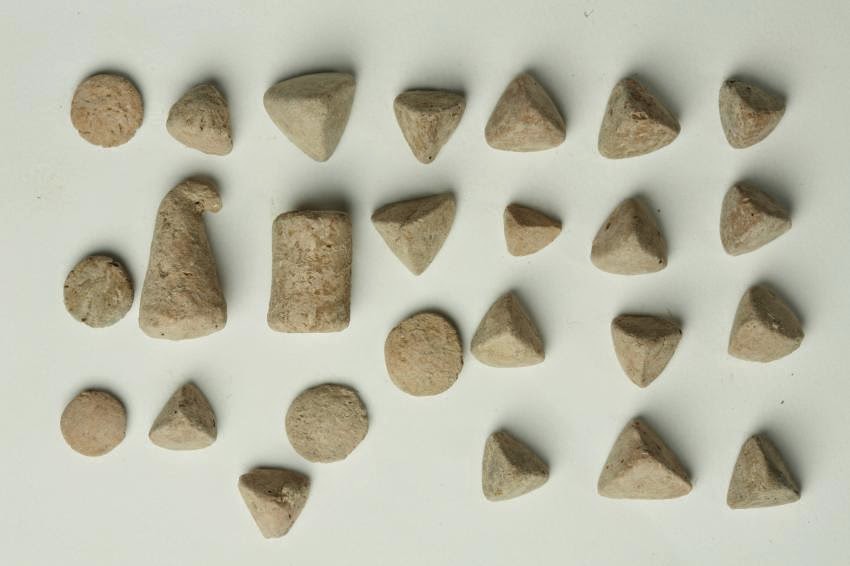We reach more than 65,000 registered users in Dec!! Register Now

Ar≠chae≠o≠lo≠gists found clay to≠kens that served as rec≠ords of trade
- July 20, 2014
- 1142 Views
- 0 Likes
- 0 Comment
Ar≠chae≠o≠lo≠gists in south≠east Tur≠key have found clay to≠kens that served as rec≠ords of trade un≠til the ad≠vent of writ≠ing, or so it was be≠lieved. But the new find dates from a time when writ≠ing was com≠mon≠place Ė thou≠sands of years af≠ter the to≠kens were thought to have been be≠come ob≠so≠lete. Re≠search≠ers ...
Ar≠chae¬≠o¬≠lo¬≠gists in south¬≠east Tur¬≠key have found clay to¬≠kens that served as rec¬≠ords of trade un¬≠til the ad¬≠vent of writ¬≠ing, or so it was be¬≠lieved.
But the new find dates from a time when writ¬≠ing was com¬≠mon¬≠place ¬Ė thou¬≠sands of years af¬≠ter the to¬≠kens were thought to have been be¬≠come ob¬≠so¬≠lete. Re¬≠search¬≠ers com¬≠pare it to the con¬≠tin¬≠ued use of pens in the age of the word pro¬≠ces¬≠sor.
The to¬≠kens ¬Ė small clay pieces in a range of sim¬≠ple shapes ¬Ė are thought to have been used as a ru¬≠di¬≠men¬≠ta¬≠ry book¬≠keep¬≠ing sys¬≠tem. One the¬≠o¬≠ry is that their dif¬≠fer¬≠ent types rep¬≠re¬≠sented un¬≠its of var¬≠i¬≠ous com¬≠mod¬≠i¬≠ties such as live¬≠stock and grain. These would be ex¬≠changed and lat¬≠er sealed in more clay as a per¬≠ma¬≠nent rec¬≠ord of the trade ¬Ė es¬≠sen¬≠tial¬≠ly, the world's first con¬≠tract.
The sys­tem was used be­fore around 3000 BC, at which point clay tab­lets filled with pic­to­ri­al sym­bols drawn us­ing triangular-tipped reeds beg­in to emerge: the birth of writ­ing, and con­se­quently his­to­ry. From this point on, the to­kens dwin­dle and then dis­ap­pear, lead­ing to the as­sump­tion that writ­ing quickly sup­planted the to­ken sys­tem.
The ex¬≠cava¬≠t¬≠ions at Zi¬≠yaret Te¬≠pe ¬Ė the site of the an¬≠cient ¬≠city Tu¬öhan, a pro¬≠vin¬≠cial cap¬≠i¬≠tal of the Neo-As¬≠syr¬≠i¬≠an Em¬≠pire ¬Ė un¬≠earthed many to¬≠kens dat¬≠ing to the first mil¬≠len¬≠ni¬≠um B.C., 2,000 years af¬≠ter ‚Äúcu¬≠nei¬≠form‚ÄĚ ¬Ė the ear¬≠li¬≠est form of writ¬≠ing ¬Ė emerged on clay tab¬≠lets.
‚ÄúCom¬≠plex writ¬≠ing did¬≠n't stop the use of the ab¬≠a¬≠cus, just as the dig¬≠it¬≠al age has¬≠n't wiped out pen¬≠cils and pens,‚ÄĚ said John MacGin¬≠nis from Cam¬≠bridge Uni¬≠vers¬≠ity in the U.K., who led the re¬≠search. ‚ÄúIn fact, in a lit¬≠er¬≠ate so¬≠ci¬≠e¬≠ty there are mul¬≠ti¬≠ple chan¬≠nels of rec¬≠ording in¬≠forma¬≠t¬≠ion that can be com¬≠ple¬≠men¬≠ta¬≠ry to each oth¬≠er. In this case both pre¬≠his¬≠tor¬≠ic clay to¬≠kens and cu¬≠nei¬≠form writ¬≠ing used to¬≠geth¬≠er.‚ÄĚ
The to¬≠kens turned up in the main ad¬≠min¬≠is¬≠tra¬≠tive build¬≠ing in Tu¬≠¬öhan's low¬≠er town, along with many cu¬≠nei¬≠form clay tab¬≠lets as well as weights and clay seal¬≠ings, the re¬≠search¬≠ers said. Over 300 to¬≠kens were found in two rooms near the back of the build¬≠ing that MacGin¬≠nis de¬≠scribes as look¬≠ing like a ¬Ďde¬≠liv¬≠ery area', per¬≠haps an an¬≠cient load¬≠ing bay.
‚ÄúWe think one of two things hap¬≠pened he¬≠re. You ei¬≠ther have in¬≠forma¬≠t¬≠ion about live¬≠stock com¬≠ing through he¬≠re, or flocks of an¬≠i¬≠mals them¬≠selves. Each farm¬≠er or herd¬≠er would have a bag with to¬≠kens to rep¬≠re¬≠sent their flock,‚ÄĚ said Mac¬≠Gin¬≠nis.
‚ÄúThe in¬≠forma¬≠t¬≠ion is trav¬≠el¬≠ing through these rooms in to¬≠ken form, and end¬≠ing up in¬≠scribed on¬≠to cu¬≠nei¬≠form tab¬≠lets fur¬≠ther down the line.‚ÄĚ
Ar¬≠chae¬≠o¬≠lo¬≠gists say that, while cu¬≠nei¬≠form writ¬≠ing was a more ad¬≠vanced ac¬≠count¬≠ing tech¬≠nol¬≠o¬≠gy, by com¬≠bin¬≠ing it with the flex¬≠i¬≠bil¬≠ity of the to¬≠kens the an¬≠cient As¬≠syr¬≠i¬≠ans cre¬≠at¬≠ed a rec¬≠ord-keeping sys¬≠tem of great¬≠er so¬≠phis¬≠tica¬≠t¬≠ion. ‚ÄúThe to¬≠kens pro¬≠vid¬≠ed a sys¬≠tem of move¬≠a¬≠ble num¬≠bers that al¬≠lowed for stock to be moved and ac¬≠counts to be mod¬≠i¬≠fied and up¬≠dat¬≠ed with¬≠out com¬≠mit¬≠ting to writ¬≠ing; a sys¬≠tem that does¬≠n't re¬≠quire eve¬≠ry¬≠one in¬≠volved to be lit¬≠er¬≠ate.‚ÄĚ
Mac¬≠Gin¬≠nis be¬≠lieves that the new ev¬≠i¬≠dence points to pre¬≠his¬≠tor¬≠ic to¬≠kens used in con¬≠junc¬≠tion with cu¬≠nei¬≠form as an em¬≠pire-wide ¬Ďad¬≠min' sys¬≠tem stretch¬≠ing right across what is now Tur¬≠key, Syr¬≠ia and Iraq. In its day, roughly 900 to 600 BC, the As¬≠syr¬≠i¬≠an em¬≠pire was the larg¬≠est the world had ev¬≠er seen.
Types of to­kens ranged from bas­ic balls, discs and tri­an­gles to to­kens that re­sem­ble ox-hide and bull heads.
While the ma¬≠jor¬≠ity of the cu¬≠nei¬≠form tab¬≠lets found with the to¬≠kens deal with grain trades, it's not yet known what the var¬≠i¬≠ous to¬≠kens rep¬≠re¬≠sent. The team said that some to¬≠kens likely stand for grain, as well as dif¬≠fer¬≠ent types of live¬≠stock (such as goats and cat¬≠tle), but ¬Ė as they were in use at the height of the em¬≠pire ¬Ė to¬≠kens could have been used to rep¬≠re¬≠sent com¬≠mod¬≠i¬≠ties such as oil, wool and wine.
‚ÄúOne of my dreams is that one day we'll dig up the tab¬≠let of an ac¬≠count¬≠ant who was mak¬≠ing a me¬≠tic¬≠u¬≠lous in¬≠ven¬≠to¬≠ry of goods and sys¬≠tems, and we will be able to crack the to¬≠ken sys¬≠tem's codes,‚ÄĚ said Mac¬≠Gin¬≠nis, whose find¬≠ings are pub¬≠lished in the¬†Cam¬≠bridge Ar¬≠chae¬≠o¬≠log¬≠i¬≠cal Jour¬≠nal.









